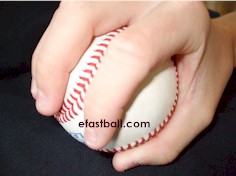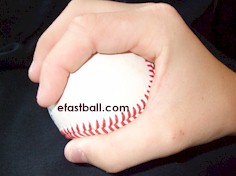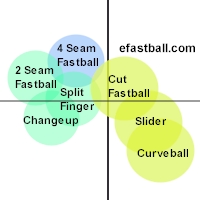How to Grip a Palm Ball Change Up



Right Handed Pitcher
- 6/22/11 revised alternate grip section
- 1/06/11 added typical speeds, reaction time
- 8/08/08 added hitter view chart
- 5/30/08 initial page
AKA
This grip is also called a change up, or an off-speed pitch.Position the Ball
Turn the ball where the seams run the direction of your fingers and the horseshoes (the "U") are close together in your palm.Then shove the ball into the palm of your hand and make sure it remains touching your palm. The closed part of the horseshoe should be in your palm. Similar to two seam fastball except the narrow seam is rotated into your palm
Position your fingers
Place your all your fingers on and around the ball without touching any seams.Position your thumb
Place your thumb directly under the ball on the smooth part of the baseball (no seam). Pull hard with your thumb to keep the ball in your palm.Exert Pressure
Squeeze the ball with all your fingers.Delivery and Release
This pitch is delivered and released just like a fastball. Open your hand as wide as possible on release to ensure that you don't pull on any seams.Your hand will pronate (thumb down, inward, clockwise LH, counterclockwise RH) slightly.
This is the same rotation as a four seam fastball, and the opposite rotation of a curveball.
Compared to other grips
A palm ball is a type of changeup and is generally 10-15 mph slower than a fastball.What the hitter sees
This ball looks like a fastball coming out of the pitchers hand.The seams (and the entire ball) will rotate slowly and the ball is rotating gently from bottom to top.
Alternate grip
Can also position the ball like a four seam fastball with the seams going across the fingers. (Be aware that this changeup may be slightly faster and may present a different spin to the hitter)Then put the second and third fingers (middle and ring fingers) on top with the first and last fingers on each side.
With any of the grips, try rotating the ball slightly on release to get more movement.
The deeper and tighter the grip, the slower the pitch. Experiment to see what works for you.
When to throw
This is probably the second most common off speed pitch (after a circle change). Alternate this with fastballs. Be sure to throw it low in the zone.What it does (movement)
The ball will move down and slightly to the right for a right handed pitcher. For a left hand pitcher, it moves down and slightly to the left.The ball creates a slow easy spin and rotates from bottom-to-top as viewed by the hitter. It should rotate slightly slower than a four seam or two seam fastball.
Reaction Time
The hitter has roughly 0.45 seconds to hit this pitch.Typical Speed
This pitch is roughly the same speed as other changeups and is generally 10-15 mph slower than a fastball.| 10 and under | 30-40 mph |
| 11-12 | 40-50 mph |
| 13-14 | 45-65 mph |
| High School | 65-75 mph |
| College/ Pro | 70-85 mph |
The ball will typically slow down 8-10 mph by the time it reaches the front of the plate. (Note that your home radar gun may stop reading well before the ball reaches the plate because the hitter is in the way.)
Catcher's Sign
Usually the catcher and the pitch caller use four fingers (or wiggle the fingers) to call a changeup.Great Palm Ball Pitchers
Roy Halladay and Trevor Hoffman are current palm ball throwers.Former players pitching palm balls include Jim Palmer and Satchel Paige.
